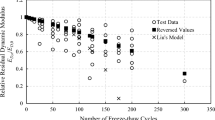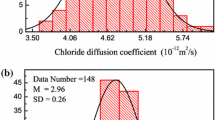Abstract
Concrete pipes are widely used for transferring water in urban infrastructure facilities. The current design standard of concrete pipes in Australia is based on the deterministic indirect-design method. However, there is uncertainty in pipe performance during service life due to assumed design parameters, installation error, changed operational environments, and pipe deterioration. This study aims to assess the reliability of structural performance of concrete pipes at the design stage. The reliability assessment is based on the use of Markov chain theory for modeling pipe deterioration during service life and coefficient of variation for representing uncertainty in design, installation, and operational parameters. The results of a case study show that increasing pipe strength from class 2 as per current design to class 3 as per reliability assessment can significantly reduce the likelihood of structural failure during service life and delay inspection and structural rehabilitation by 10 years. There is a difference in structural deterioration between pipe cohorts, which should be taken into account for reliability-based design.




Similar content being viewed by others
References
E. Erdogmus, B. Skourup, M. Tadros, Recommendations for design of reinforced concrete pipe. J. Pipeline Syst. Eng. Pract. 1(1), 25–32 (2010)
M. Mahmoodian, A.M. Alani, Multi-failure mode assessment of buried concrete pipes subjected to time-dependent deterioration, using system reliability analysis. J. Fail. Anal. Prev. 13(5), 634–642 (2013)
ASCE 15-98, Standard Practice for Direct Design of Buried Precast Concrete Pipe Using Standard Installations. ASCE (1998)
T. de Larrard, E. Bastidas-Arteaga, F. Duprat, F. Schoefs, Effects of climate variations and global warming on the durability of RC structures subjected to carbonation. Civ. Eng. Environ. Syst. 31(2), 153–164 (2014)
A. De La Fuente, R.C. Escariz, A.D. De Figueiredo, C. Molins, A. Aguado, A new design method for steel fibre reinforced concrete pipes. Constr. Build. Mater. 30, 547–555 (2012)
M. Najafi, G. Ramirez, R. Mielke, B. Keil, G. Davidenko, S. Rahman, A. Jain, Design, analysis, and full-scale testing of the rolled groove gasket joint system in AWWA C303 bar-wrapped, steel-cylinder concrete pressure pipe. J. Pipeline Syst. Eng. Pract. 4(3), 156–169 (2013)
A. Peyvandi, P. Soroushian, S. Jahangirnejad, Structural design methodologies for concrete pipes with steel and synthetic fiber reinforcement. ACI Struct. J. 111(1), 83–91 (2014)
Z. Luo, F. Xiao, R. Sharma, Efficient reliability-based approach for mechanistic-empirical asphalt pavement design. Constr. Build. Mater. 64, 157–165 (2014)
V.S. Nguyen, M.C. Jeong, T.S. Han, J.S. Kong, Reliability-based optimisation design of post-tensioned concrete box girder bridges considering pitting corrosion attack. Struct. Infrastruct. Eng. 9(1), 78–96 (2013)
A.W. Stuedlein, W.J. Neely, T.M. Gurtowski, Reliability-based design of augered cast-in-place piles in granular soils. J. Geotech. Geoenviron. Eng. 138(6), 709–717 (2012)
M. Kaszynska, A.S. Nowak, Target reliability for design and evaluation of bridges. In Proceedings of the 5th International Conference on Bridge Management, 2005, pp. 401–408
AS 3725, Design for Installation of Buried Concrete Pipes. Standard Australia (2007)
C. Cao, M.M.S. Cheung, B.Y.B. Chan, Modelling of interaction between corrosion-induced concrete cover crack and steel corrosion rate. Corros. Sci. 69, 97–109 (2013)
T. Fatima, A. Muntean, Sulfate attack in sewer pipes: derivation of a concrete corrosion model via two-scale convergence. Nonlinear Anal. Real World Appl. 15, 326–344 (2012)
M. Boehm, J. Devinny, F. Jahani, G. Rosen, On a moving-boundary system modeling corrosion in sewer pipes. Appl. Math. Comput. 92(2–3), 247–269 (1998)
R.E. Melchers, C.Q. Li, Phenomenological modeling of reinforcement corrosion in marine environments. ACI Mater. J. 103(1), 25–32 (2006)
S. Guzmán, J.C. Gálvez, J.M. Sancho, Modelling of corrosion-induced cover cracking in reinforced concrete by an embedded cohesive crack finite element. Eng. Fract. Mech. 93, 92–107 (2012)
A. Jamali, U. Angst, B. Adey, B. Elsener, Modeling of corrosion-induced concrete cover cracking: a critical analysis. Constr. Build. Mater. 42, 225–237 (2013)
Z. Liu, Y. Kleiner, State of the art review of inspection technologies for condition assessment of water pipes. Meas. J. Int. Meas. Confed. 46(1), 1–15 (2013)
S. Shahidan, R. Pulin, N. Muhamad Bunnori, K.M. Holford, Damage classification in reinforced concrete beam by acoustic emission signal analysis. Constr. Build. Mater. 45, 78–86 (2013)
WSAA, Conduit Inspection Reporting Code of Australia (Water Service Association of Australia (WSAA), Melbourne, 2006)
T. Micevski, G. Kuczera, P. Coombes, Markov model for storm water pipe deterioration. J. Infrastruct. Syst. 8(2), 49–56 (2002)
D.H. Tran, B.J.C. Perera, A.W.M. Ng, Markov and neural network models for prediction of structural deterioration of stormwater pipe asset. J. Infrastruct. Syst. ASCE 16(2), 167–171 (2010)
T.S. Ariaratnam, E.A. Assaly, Y. Yuqing, Assessment of infrastructure inspection needs using logistic models. J. Infrastruct. Syst. ASCE 7(4), 66–72 (2001)
D.H. Tran, B.J.C. Perera, A.W.M. Ng, Comparison of structural deterioration models for stormwater drainage pipes. Comput. Aided Civ. Infrastruct. Eng. 24(2), 145–156 (2009)
D.H. Tran, A.W.M. Ng, K.J. McManus, S. Burn, Prediction models for serviceability deterioration of stormwater pipes. Struct. Infrastruct. Eng. 4(4), 287–295 (2008)
R.E. Melchers, Structural Reliability Analysis and Prediction (Wiley, Chichester, 1999)
R. Sadiq, B. Rajani, Y. Kleiner, Probabilistic risk analysis of corrosion associated failures in cast iron water mains. Reliab. Eng. Syst. Saf. 86(1), 1–10 (2004)
AS 4058, Australia Standard AS 4058-2007 Precast Concrete Pipes (Pressure and Non-pressure). Engineers Australia (2007)
Acknowledgments
The author gratefully acknowledges the kind support of Brimbank City Council, especially Dominic Di Martino and Abu Rahman.
Author information
Authors and Affiliations
Corresponding author
Rights and permissions
About this article
Cite this article
Tran, H.D. Reliability-Based Structural Design of Concrete Pipes. J Fail. Anal. and Preven. 14, 818–825 (2014). https://doi.org/10.1007/s11668-014-9894-3
Received:
Published:
Issue Date:
DOI: https://doi.org/10.1007/s11668-014-9894-3




